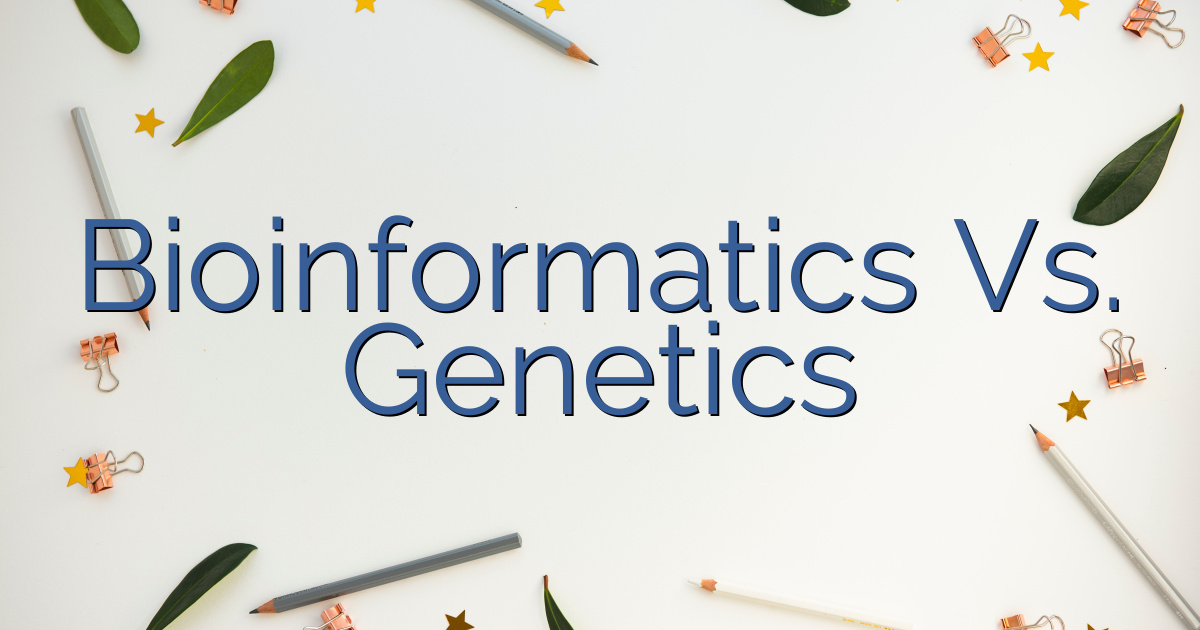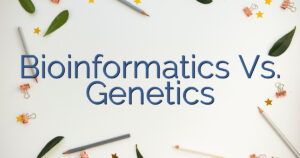 Did you know that the fields of bioinformatics and genetics are both rapidly growing in the world of science and research? With the increasing importance of data analysis and genetic research, it’s crucial to understand the differences and similarities between these two majors.
In this article, we will explore the curriculum, technical skills developed, career opportunities, and salary potential in both bioinformatics and genetics. By the end, you’ll have a better understanding of which major aligns with your interests and goals.
So, let’s dive in!
Did you know that the fields of bioinformatics and genetics are both rapidly growing in the world of science and research? With the increasing importance of data analysis and genetic research, it’s crucial to understand the differences and similarities between these two majors.
In this article, we will explore the curriculum, technical skills developed, career opportunities, and salary potential in both bioinformatics and genetics. By the end, you’ll have a better understanding of which major aligns with your interests and goals.
So, let’s dive in!
Table of Contents
Key Takeaways
- Bioinformatics and Genetics are two rapidly growing majors in science and research.
- Both majors require learning programming languages like Python and R.
- Practical lab experience is crucial in both majors for applying theoretical knowledge to real-world scenarios.
- Bioinformatics professionals can work in pharmaceuticals, healthcare, and research institutions, while Genetics professionals can pursue careers as genetic counselors, clinical geneticists, or research scientists.
Overview of the two majors: Bioinformatics and Genetics
Bioinformatics and Genetics are two majors that have distinct focuses and career paths. In the field of bioinformatics, job prospects are abundant due to the increasing demand for professionals who can analyze and interpret vast amounts of biological data. With advancements in technology, there is a growing need for bioinformaticians who can develop algorithms and computational tools to analyze genomic data and understand its implications. On the other hand, genetics majors often find opportunities in research institutions, healthcare organizations, and pharmaceutical companies. They play a crucial role in studying inherited traits, diseases, and genetic disorders. However, both majors require interdisciplinary skills. Bioinformatics professionals need a strong foundation in both biology and computer science, while genetics majors benefit from combining biology with statistics or molecular biology. Interdisciplinary skills are essential in these fields as they enable professionals to tackle complex problems and contribute to cutting-edge research in genetics and bioinformatics.Overview of the curriculum of the two majors: Programming
You’ll learn programming languages like Python and R in both the bioinformatics and genetics curriculums. Programming plays a crucial role in both bioinformatics and genetics due to its importance in data analysis, algorithm development, and automation of tasks. In bioinformatics, programming is essential for handling large datasets generated by various high-throughput technologies, such as next-generation sequencing. It enables the analysis of genomic data, identification of genetic variations, and prediction of protein structure and function. In genetics, programming is vital for developing computational models, simulating genetic processes, and analyzing complex genetic traits. Furthermore, programming allows for the development of software tools and algorithms that aid in the interpretation of genetic data and facilitate the discovery of new genes or genetic variants. Overall, programming skills are essential for both fields, enabling researchers to leverage computational approaches to solve complex biological problems.Overview of coursework and assessments in Bioinformatics and Genetics
In both the bioinformatics and genetics curriculums, you will have coursework and assessments that focus on programming languages like Python and R. These languages are essential in analyzing and interpreting large datasets in both fields. However, it is not just programming that you will be learning. Practical lab experience is also crucial in bioinformatics and genetics coursework, as it allows you to apply theoretical knowledge to real-world scenarios. This hands-on experience helps you develop critical skills such as experimental design, data analysis, and troubleshooting. Bioinformatics and genetics play a vital role in personalized medicine. With advances in genomic technologies, scientists can now analyze an individual’s genetic information to predict disease risk, response to treatment, and tailor therapies accordingly. Understanding the genetic basis of diseases through bioinformatics and genetics is essential in developing targeted therapies and improving patient outcomes.Comparison of Technical Skills Developed
When comparing the technical skills developed in these fields, it’s important to understand the practical applications of programming languages like Python and R. These languages are widely used in both bioinformatics and genetics research due to their versatility and powerful analytical capabilities. In bioinformatics, Python and R are used for data analysis, visualization, and machine learning algorithms. In genetics research, these programming languages are essential for analyzing large-scale genomic data, identifying genetic variations, and predicting disease risks. The impact of bioinformatics on genetics research cannot be overstated, as it has revolutionized our ability to analyze and interpret vast amounts of genetic data. Through the comparison of analytical techniques and the use of sophisticated programming languages, bioinformatics has accelerated the pace of genetic discoveries and brought us closer to unlocking the mysteries of the genome.| Skills Developed in Bioinformatics | Skills Developed in Genetics Research | Practical Applications |
|---|---|---|
| Data analysis | Genomic data analysis | Identify genetic variations, predict disease risks |
| Machine learning algorithms | Statistical analysis | Predict disease outcomes, personalize treatments |
| Visualization techniques | Genetic mapping | Understand genetic relationships, identify disease genes |
Comparison of Career Opportunities and Job Roles in Bioinformatics and Genetics Fields
To understand the potential career opportunities and job roles in the fields of bioinformatics and genetics, it’s important to explore the practical applications and demand for professionals with expertise in analyzing genetic data and developing computational models. When it comes to job prospects, both fields offer promising opportunities. In bioinformatics, professionals can work in various sectors such as pharmaceuticals, healthcare, and research institutions. They may find roles as bioinformatics scientists, data analysts, or software developers. On the other hand, genetics professionals can pursue careers as genetic counselors, clinical geneticists, or research scientists. While bioinformatics requires strong computational and programming skills, genetics professionals need a solid understanding of molecular biology and genetics. Both fields are in high demand, with opportunities for growth and advancement. It’s important to consider your interests and skills when deciding which path to pursue.Comparison of Salary Potential: Job Market Trends
The job market trends show a significant difference in salary potential between the two fields. When considering career options in bioinformatics and genetics, it is important to take into account the job market demand and salary growth potential. Here are some key points to consider:- Bioinformatics offers higher salary potential: Due to the increasing demand for skilled professionals in analyzing biological data, bioinformatics positions tend to have higher salaries compared to genetics roles.
- Genetics salaries vary based on specialization: While genetics positions may not have as high of a salary potential as bioinformatics, the salary can still vary depending on the specific area of specialization. For example, roles in clinical genetics or genetic counseling may offer higher salaries compared to research-oriented positions.
- Both fields have promising salary growth potential: With advancements in technology and research, both bioinformatics and genetics are expected to experience steady salary growth in the coming years.
Similarities between Bioinformatics and Genetics curricula
There are similarities in the curricula of both bioinformatics and genetics. Both fields require a strong foundation in molecular biology, genetics, and statistics. Understanding the principles of DNA, RNA, and protein structure is essential in both disciplines. Additionally, both fields emphasize the use of computational tools and programming languages to analyze and interpret large-scale biological data. Bioinformatics and genetics also offer interdisciplinary opportunities, allowing researchers to collaborate with experts in computer science, mathematics, and other related fields. This interdisciplinary approach fosters innovation and allows for a more comprehensive understanding of biological systems. By combining the study of genetics with bioinformatics, researchers can explore the vast amount of genetic information available and uncover valuable insights into the genetic basis of diseases, evolutionary patterns, and population genetics. Overall, the curricula of bioinformatics and genetics share similarities and offer exciting interdisciplinary prospects for scientific exploration.What is the difference between Bioinformatics and Genetics?
Genetics is the study of genes and heredity, while bioinformatics involves the use of computer technology to analyze biological data. The difference between biophysics and bioinformatics lies in their focus: one deals with physical principles in biological systems, while the other focuses on analyzing biological information using computational tools.
Difference between Bioinformatics and Genetics curricula
When studying the differences between the curricula of bioinformatics and genetics, you’ll find that bioinformatics focuses more on computational analysis and programming, while genetics emphasizes understanding the principles of inheritance and genetic variation. Here are three key differences between the two fields:- Practical applications of bioinformatics in genetics research: Bioinformatics plays a crucial role in analyzing large-scale genetic data, such as DNA sequencing data. It helps in identifying and characterizing genes, predicting protein structures, and understanding gene expression patterns. This enables researchers to gain valuable insights into the genetic basis of diseases, drug development, and personalized medicine.
- Ethical considerations in bioinformatics and genetics studies: As bioinformatics involves handling sensitive genetic information, ethical considerations are paramount. Issues such as informed consent, privacy, and data sharing need to be carefully addressed to protect the rights and interests of individuals. Additionally, bioinformatics researchers must adhere to ethical guidelines and regulations to ensure responsible and transparent use of genetic data.
Factors to consider when choosing between Bioinformatics and Genetics majors: Interdisciplinary opportunities
One important factor to consider when choosing between majors in bioinformatics and genetics is the opportunity for interdisciplinary collaboration. Both fields offer unique research opportunities, but the level of collaboration with other disciplines varies. Bioinformatics, as the name suggests, combines biology with computer science and data analysis. This interdisciplinary approach allows for collaborations with computer scientists, statisticians, and mathematicians. On the other hand, genetics, while still a highly research-oriented field, tends to focus more on the study of genes and heredity. The table below compares the level of interdisciplinary collaborations and research opportunities between bioinformatics and genetics.| Factor | Bioinformatics | Genetics |
|---|---|---|
| Interdisciplinary Collaborations | High | Moderate |
| Research Opportunities | Broad range of applications in various disciplines | Focus on genes and heredity |

